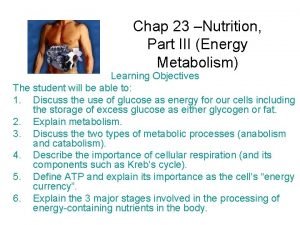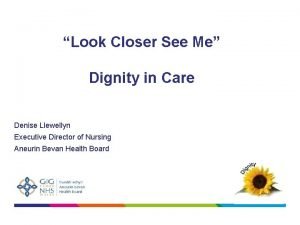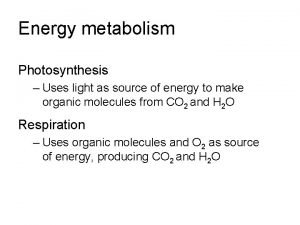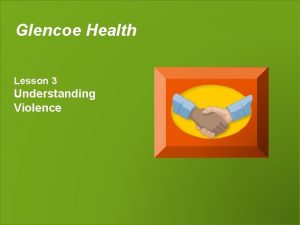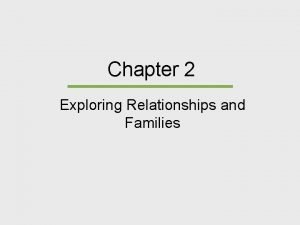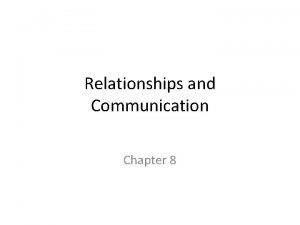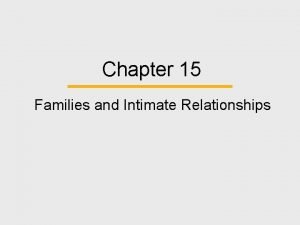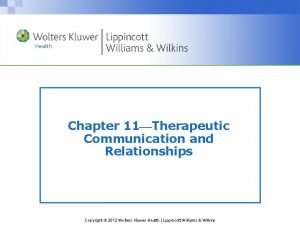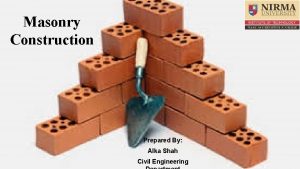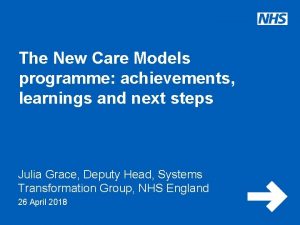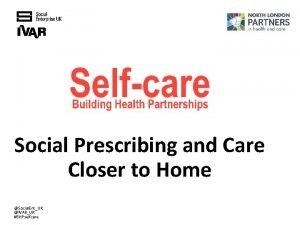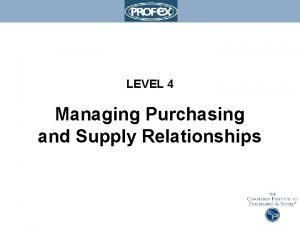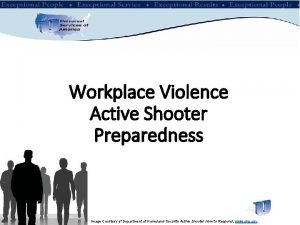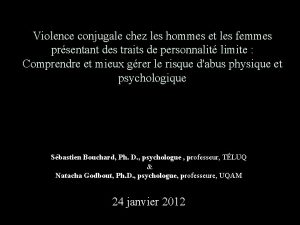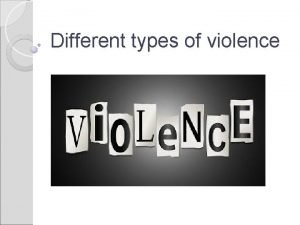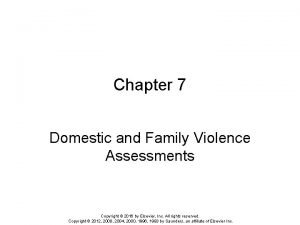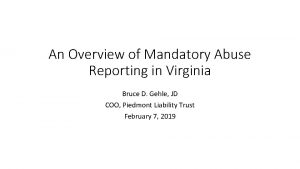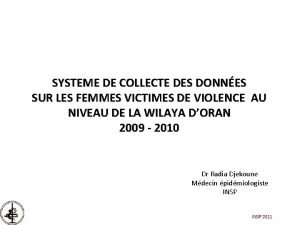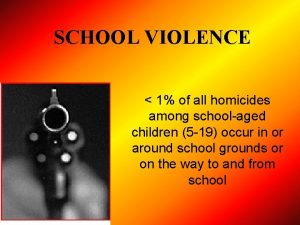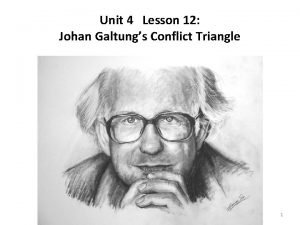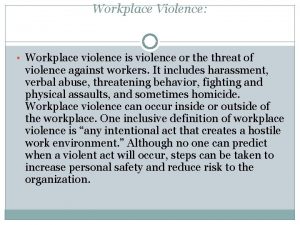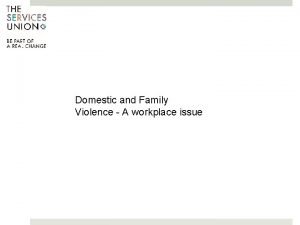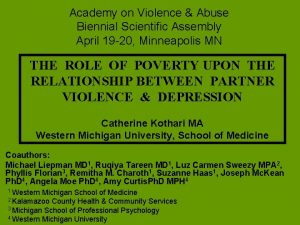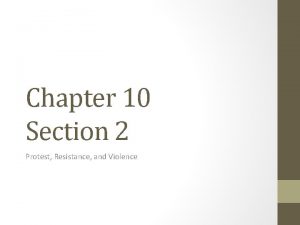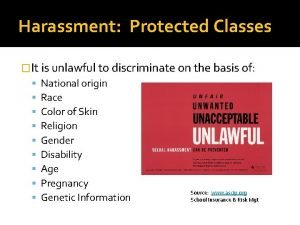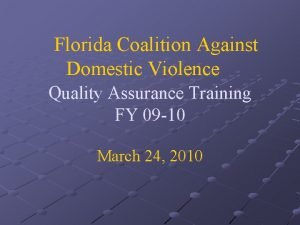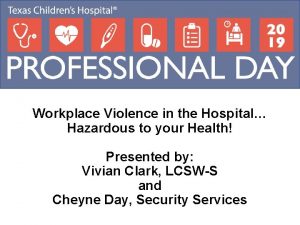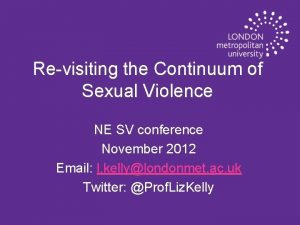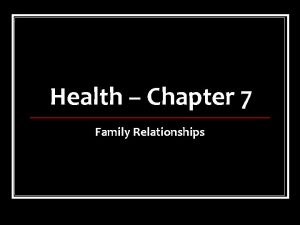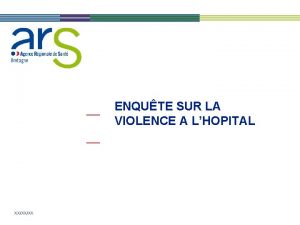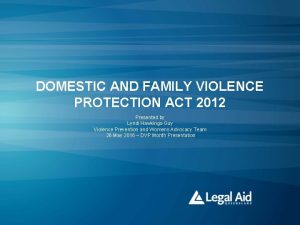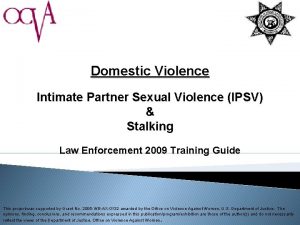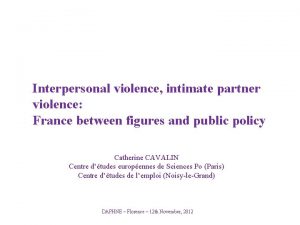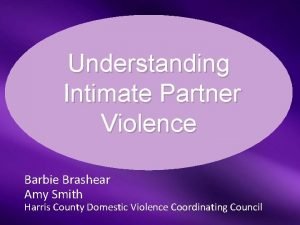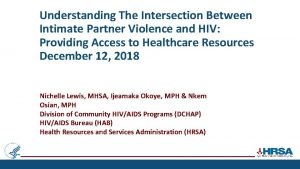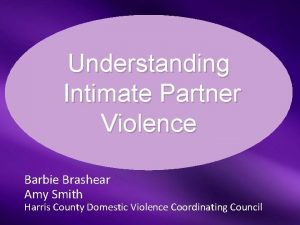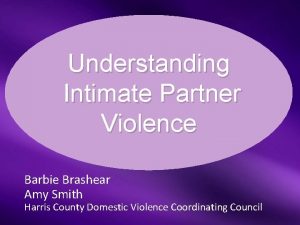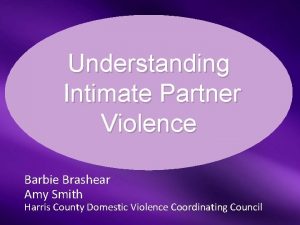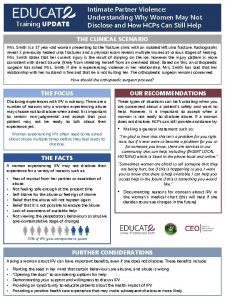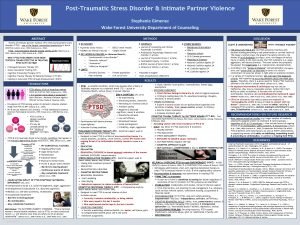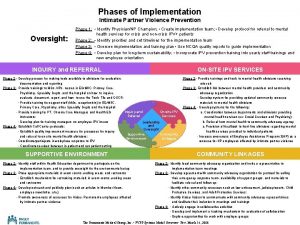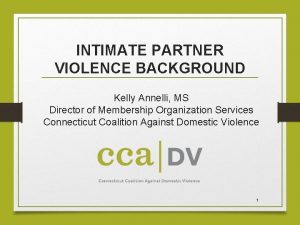A Closer look at Intimate Partner Violence Understanding






















































































- Slides: 86

A Closer look at Intimate Partner Violence: Understanding and Working with Perpetrators

Alan Rosenbaum, Ph. D. Northern Illinois University and The Center for the Study of Family Violence and Sexual Assault arosenbaum@niu. edu

In intimate adult relationships, who is more likely to hit: a) the man b) the woman c) equally likely

If only one of the partners is aggressive, who is it most likely to be? a) the man b) the woman c) equally likely

According to the findings of the National Family Violence Survey (1975, 1985) in approximately half of the families reporting violence, both partners were physically aggressive, and the remainder of the cases were about evenly divided between women and men as the sole perpetrator. n In addition, women and men reportedly engaged in equal amounts of verbal and emotional aggression n

True or False: Men are more likely than women to use severe violence When there is intimate partner aggression, who is most likely to be injured? Should a woman who behaves aggressively toward her male partner be labeled a “batterer”?

When a woman hits a man it is _______ in self defense? a) always b) almost always c) about half the time c) rarely

Regarding who hits first, Straus & Gelles, 1990 reported that women struck first in 45% of the cases (according to the men) and in 42% of the cases according to the women themselves. n Straus (1993) reported that in representative community samples, at least 25% of the violence by women was not self-defensive in that the woman was the only perpetrator in the past twelve n

Rosenbaum et al. (2003, Unpublished) n n n Sample: Males n= 95, Females n=101 Individuals are reporting on their own behavior and experiences. Categories are mutually exclusive Gen Non e Perp Vict Both Male 46% 4. 2% 18% 32% Fem 50% 5. 0% 9% 37%

Intimate terrorism v. common couple violence n Intimate terrorism ¨ More severe ¨ Patterned ¨ Primarily male perpetrated ¨ Function: control of the partner n Common couple violence ¨ Less severe ¨ Results from stress and conflict within the relationship ¨ Perpetrated equally by both genders ¨ Function: conflict resolution

Importance of female perpetrated aggression n Aggression perpetrated by either gender negatively affects witnessing children (Jaffe, Wolfe & Wilson, 1990). Women’s mild aggression towards their partners predicted future severe aggression by their partners towards the women. (Feld & Straus, 1989). Women’s use of psychological aggression has been shown to predict future aggression by husbands who had not been previously aggressive (Murphy & O’Leary, 1989)

Characteristics of female perpetrators n n n n High rates of childhood victimization (physical and sexual) High rates of physical victimization as adults 1/3 to ½ witnessed inter-parental aggression. Past and current substance abuse 2/3 had a history of outpatient mental health treatment (Leisring et al. , 1999) 45% experiencing clinical levels of PTSD (Leisring, Dowd, and Rosenbaum, 2000) 32% have made at least one suicide attempt (Leisring et al. , 1999)

True or False: All batterers are the same!

Typologies Batterers are now recognized to be a heterogeneous group. n Numerous typologies have been proposed. Holtzworth-Munroe and Stewart’s three group typology has received the most attention. n ¨ Family only ¨ Borderline/dysphoric ¨ Generally violent/Anti-social

Only Snyder & Fruchtman incorporated dyadic factors in their typology. n There is substantial evidence that dyadic factors are important determinants of aggression. n ¨ Anxiously attached males paired with avoidant women ¨ Traditional males paired with non-traditional women

True or False: All intimate partner violence is caused by the male’s need for power and control.

Exposure to interparental aggression Picked on or bullied as a child Inability to protect mother Men as sexual pursuers, women as gatekeepers (Brooks) Dependence on women Victim of physical or sexual abuse Feelings of powerlessness Need for power and control The need to be in control is central to a sense of masculinity (Scher, 1990) Paradox of male power (Kimmel, 1994)

Many males brought up by women Male tendency to sexualize intimacy restricts male friendships Single parent homes especially common among poor and minority Women may cut men off from male friends and activities According to Lamb fathers spend, on average only 12 minutes a day with young children Woman becomes only source of intimacy and support and an emotional outlet which is integral to mental health Dependence on women

Connectedness n What are your connections? ¨ Friends ¨ Partner ¨ Parents ¨ Children ¨ Job ¨ Religion ¨ Community n n n School Pets Organizations

The National Longitudinal Study on Adolescent Health N=12, 118 interviews of adolescents in grades 7 -12 n Health risk behaviors: n ¨ emotional distress- depression ¨ suicidality- ideation or attempts ¨ violence ¨ cigarettes or substance use ¨ sexual activity and teen pregnancy

n Conclusion: parent-family connectedness and perceived school connectedness was protective against every health risk behavior except history of pregnancy. ¨ Included closeness to a parent, perceived caring by a parent, feeling loved and wanted. ¨ Engaged in activities with a parent ¨ Feel that teachers treat students fairly, closeness to people at school, feel a part of

Attachment: One aspect of Connectedness Defective relationships with parents leads to defects in attachment. n Individuals who are anxiously attached are acutely sensitive to abandonment. n When sensing abandonment, anxiously attached individuals engage in hyperactivating strategies intended to restore closeness to the attachment figure. n Hyperactivating strategies may be associated with stalking. n

Mikulincer (1998)- Anxiously attached individuals held negative expectations of their partners in response to hypothetical situations and made overly negative appraisals of the partner’s intent. n They also reacted with hostility and anger to ambiguous cues, as opposed to clear hostile cues. n Dutton et al. (1994) DV males higher on attachment anxiety than community n

Relationship acceleration Getting in too deep too quickly. n Reduces opportunities to exit the relationship. n Exit points refer to unresolvable differences that would normally result in termination of the relationship. n ¨ Examples: different ideas regarding children, religious differences, lack of common interests, sexual incompatibility. n May be associated with attachment

Relationship Acceleration. Rosenbaum et al. (2003, unpublished) Utilized the dating behaviors questionnaire. n Asked participants to report how soon after the first date with someone, various behaviors occurred. n DBQa factored into three distinct and nonoverlapping factors: DBQsex, DBQrel, and DBQown n

DBQsex- Sample items n How soon after the first date: ¨ Engage in kissing and hugging ¨ Touched by partner on chest/breasts on top of clothing ¨ Touched by partner on chest/breasts skin to skin ¨ Touch partner on chest/breasts on top of clothing ¨ Touch partner on chest/breasts skin to skin ¨ Touch partner on genitals on top of clothing

DBQrel- Sample items n How soon after the first date: ¨ Go out on a second date ¨ Call partner on phone ¨ Called by partner on phone ¨ Consider partner to be your boy/girlfriend ¨ Agree to date exclusively ¨ Receive a gift/give a gift (separate items) ¨ Spend an entire day together

DBQown- Actual Items n How soon after the first date: ¨ Feel you have a right to know where your partner is and who he/she is with. ¨ Feel you have a right to be angry if he/she dates someone else. ¨ Feel guilty about not seeing your partner on a weekend night. ¨ Feel guilty about flirting with someone else.

Preliminary findings- Males only n DBQsex ¨ Nonviolent Mean 52. 02 ¨ Violent n DBQrel n DBQown ¨ Nonviolent ¨ Violent 18. 84 42. 53 p=. 02 S. D F=5. 53 17. 00 No significant diffs. 24. 60 6. 81 22. 70 F=1. 97 4. 89

Relationship acceleration additional findings of interest n n n No significant differences for women on any of the DBQ scales. Regarding number of dating partners over lifetime, violent individuals of both genders have significantly more suggesting that these relationships don’t last and perhaps further sensitizing aggressive individuals to signs of disinterest Comparing real and ideal ratings on the DBQ items, females would like everything to go slower, males would like everything to go faster, irrespective of aggressiveness (Are you

Future Orientation n Where do you see yourself five years from now ¨ Vocationally ¨ Relationships ¨ Housing ¨ Children and family

What are the immediate results of aggression? You get your way. n Tension reduction n Feelings of power or superiority n Feelings of control n Affirmation of masculinity n Stop the nagging n

What are the long term consequences? Feelings of shame n Loss of intimacy n Damage to, or loss of relationship n Legal consequences n Financial consequences n Social consequences n Effects on children n Degraded relationship with children n

Immediate consequences of aggression are mostly positive Reinforcement of aggression Long term consequences of aggression are mostly negative Reduction of aggression Foreshortened future

Behaviors of high habit strength Poor self-esteem Picked on or bullied as child Exposure to violence in FOO Dysfunctional relationships Jealousy Personality Disorder Attachment problems Threshold Head injury Alc or subst use/abuse Pers traits.

Biological Factors Head Injury n Neuropsychological functioning n ¨ Executive functioning ¨ Poor impulse control Serotonin Deficits n Limbic System n Brain Morphology n

Head Injury in Partner Abusive Men Rosenbaum et al. (1994) n n n Purpose- To assess the prevalence of a hx of significant head injury in a sample of batterers as compared to two samples of non-aggressive men. Subjects ¨ N=130 [53 Batterers, 32 Discord, 45 Satisfied] ¨ Predominantly Caucasian ¨ Average of groups between 31 and 40 Measures ¨ Conflict Tactics Scale (CTS) ¨ Locke-Wallace SMAT (SMAT) ¨ SCL-90 -R (SCL-90) ¨ Medical Hx Interview

Criteria for Significant Head Injury n n Mild ¨ LOC< 1 hr duration, head injury w/o LOC but with subsequent objective sequelae, or no fewer than 2 subjective sequelae of moderate intensity Moderate ¨ LOC> 1 hr but < 24 hrs Severe ¨ LOC > 24 hrs Sub-clinical ¨ Reported minor head trauma that did not meet criteria for mild, moderate or severe, as described above

Results and Conclusions n n n Significant head injury in 53% of Batterers ¨ Compared to 25% of Discord and 16% of Satisfied Head injury a significant predictor of being a Batterer ¨ Odds ratio=5. 82 In 93. 1% of cases, head injury preceded the first instance of marital aggression Mean age at time of head injury=12. 5 years ¨ >50% injured prior to age 11, 75% prior to age 16 Almost 79% of men with a moderate or severe head injury were in the Batterers group No association between subclinical head injury and

Neuropsychological Assessment of Batterers Purpose: To assess whether it was possible to identify cognitive impairments in abusive men using a battery of neuropsychological tests, and whether any impairments might explain the association between head injury and battering. n Subjects- Neuropsychological assessments were conducted as part of Rosenbaum et al. , 1994, thus the subject pool is the same. Adequate data was only available for 102 of the 130 subjects. n

Results and Conclusions n n No differences between Discord and Satisfied subjects on any neuropsych measure, consequently these groups were pooled as a generic non-aggressive group Batterers differed from non-batterers on ARCPT, WCST, Digit symbol, RMT (Faces and Words), NSRT with Batterers showing weaker performance. Head injured subjects could also be reliably discriminated from non-head injured subjects an many measures, however among Batterers, neuropsych performance did not vary as a function of head injury status. Batterers had weaker verbal intellectual performance,

Conclusions n n On the basis of performance on 5 neuropsych measures it was possible to correctly classify Batterers more than 80% of the time Failure to find differences between head injured and non-head injured batterers suggests that head injury, itself, was not the source of cognitive dysfunction among batterers. Prior head injury, however, was among the variables most strongly correlated with neuropsychological dysfunction Greatest discriminatory power was attained when neuropsychological measures, hx of head injury were considered along with ETOH abuse hx, childhood discipline problems, and curent level of emot. distress, as referenced by the General Severity Index of the SCL-90.

MVA Sports related Maltreatment Parental neglect Head Injury Reduced Serotonergic activity Impaired Neurological functioning Dysthymia Depression Aggression impulsivity Poor impulse control Alixithymia Emotional recognition Emotional negativity

Limbic system Plays a pivotal role in the regulation of emotion and memory n Includes the amygdala and the hippocampus n These areas are often implicated in emotionality and especially aggression n Research using MRI supports a relationship between childhood abuse and the size of the hippocampus and amygdala in adults n

n n Stein (1997) found left hippocampal abnormalities in adult women who had been sexually abused as children and suffered from PTSD. Bremner (1997) found left hippocampus of adult survivors of physical or sexual abuse (with PTSD) to be 12% smaller than healthy controls PTSD and emotional dysregulation common among women referred for anger management and treatment of IPV And possibly men, as well

Child maltreatment Stress cortisol Affects brain development Alteration of GABA receptors Increased limbic irritability Aggression Emotional negativity Emotional dysregulation

Serotonergic Functioning

Screening Criteria Males 18 -65 Years of Age n Not currently taking any medication n No history of cardiac disease, hypertension, pituitary disease, visual field defect, or hypogonadism n No history of psychosis, arrhythmia, cardiac ischemia or adverse reaction to fenfluramine n No history of drug or alcohol abuse in past six months. n Ability and willingness to forego smoking during protocol n Currently involved in some level of heterosexual n

Characteristics of Participants N=74 ¨ Partner Abusive: N=36 ¨ Non-abusive controls: N=38 n Mean age=35. 2 n Mean Income=$20, 520 ($US) ¨ Partner’s Mean Income=$13, 900 ($US) n Marital Satisfaction (Locke-Wallace SMAT)=96 ¨ Partner Abusive: Mean=88 ¨ Non-abusive controls: Mean=103 n Race: 89. 6% Caucasian n

Results n Main Effects No significant differences between head-injured and non head-injured subjects on prolactin response over hours 4, 5, & 6. ¨ No significant differences between partner abusers and controls on prolactin response over hours 4, 5, & 6. ¨ n n Wilks’ lambda=. 98, F (2, 69)=. 80, ns. Wilks’ lambda=. 96, F (2, 69)=1. 41, ns. n Interactions ¨ Head Injury x Abuse x Time- Partner abusers

Fig. 1 - Mean Prolactin Levels (ng/ml) Following d, l-Fenfluramine (60 mg) Administration at Hour 1

Results n Follow-up Repeated Measures MANOVA comparing partner abusers and controls in non head-injured groups- Partner abusers showed significant blunting of prolactin response over time as compared to controls. ¨ Wilks’ lambda=. 85, F (2, 41)=3. 49 p=. 04 n n Linear univariate: t (1)=-. 80, ns. Quadratic univariate: t (1)=2. 48, p<. 02

COGNITIVE DIFFERENCES BETWEEN BATTERERS AND NON-BATTERERS Gearan and Rosenbaum (In Preparation)

SUBJECT CHARACTERISTICS n 65 Men who were married or in a heterosexual, monogamous relationship of at least 6 months in duration ¨ Abusive (n = 25) n CTS > 11 ¨ Discordant (n = 21) n CTS < 10 SMAT < 95 ¨ Satisfied (n = 19) n CTS < 10 n SMAT > 95 Mean age = 36. 75 n n

COGNITION CATEGORIES n n n n Positive attributions about self (“I am a good husband”) Negative attributions about self ( “I’m a failure at my job”) Positive attributions about others (“She works hard”) Negative attributions about others (“She’s always nagging”) Empathy (“I know she has a lot to do”) Problem Solving - Self (“I could help out more”) Problem Solving - Other (“She needs to be more understanding”) Problem Solving - Cooperative (“We could take turns watching the children”)

Non-Batterers vs. Batterers

Low vs. High Frequency Batterers

Satisfied, Discordant, Low Violence, and High Violence

Summary n n n Batterers, as compared with non-batterers, produce more negative cognitions only in the female provocative condition. High frequency, as compared to low frequency, batterers are more verbally abusive, have lower relationship satisfaction, and make more negative statements about themselves. Low frequency batterers do not significantly differ from satisfied or discordant men, but high frequency batterers do show some differences in cognitive productions from the other groups.

Results n Follow-up Repeated Measures MANOVA comparing partner abusers and controls in non head-injured groups- Partner abusers showed significant blunting of prolactin response over time as compared to controls. ¨ Wilks’ lambda=. 85, F (2, 41)=3. 49 p=. 04 Linear univariate: t (1)=-. 80, ns. n Quadratic univariate: t (1)=2. 48, p<. 02 n

Developmental Factors How we raise our sons and daughters and the acceptability of aggression

Developmental Psychopathology ODD, ADHD, PTSD, and negative childhood experiences From: Rosenbaum & Leisring

Demographics n Batterers n General Public ¨ N=118 ¨ N=149 ¨ Mean age= 30. 06 ¨ 71% Caucasian ¨ 14. 3% African American ¨ 11. 6% Hispanic age= 33. 01 ¨ 73. 6% Caucasian ¨ 11. 8% African American ¨ 8. 3% Hispanic

Measures n n n n n Childhood Trauma Questionnaire (Bernstein et al. , 1994) Self Ratings of ADHD/ODD (Murphy & Barkley, 1996) PTSD Checklist- Civilian version (Weathers et al. , 1991) SCL-90 -R (Derogatis, 1986) SMAST (Selzer, Vinokur & van Rooijen, 1975) Conflict Tactics Scale (Straus, 1979) Life History of Aggression Scale (Coccaro Berman & Kavoussi, 1997) Barratt Impulsiveness Scale (Barratt, 1994) Childhood Experiences Questionnaire (Rosenbaum & Gearan, 1999)

Differences between batterers and the general population comparison group on the Childhood Experiences Questionnaire n Batterers were: n more likely to report seeing their fathers drunk* ¨ more likely to have seen their fathers hit their mothers** ¨ more likely to report getting beaten up by their mothers* ¨ less likely to be told that they were loved by a parent** ¨ less likely to report that their fathers came to watch them perform in school activities or sports* ¨ more likely to get into fights with other children* ¨ more likely to have beaten up another child* ¨ more likely to have cut school** ¨ more likely to get into legal trouble as children** * p<. 005 **p<. 0001 ¨

Negative Emotionality n n Negative reactions to stress Experience emotions negatively Negative expectations of others Positive attitudes toward the use of aggression n n I often get irritated at little annoyances I don’t know why I feel angry all the time People will take advantage of you if you let them If someone hits me, I get them back

PTSD Abuse History Head Injury Defective rel. with parents Poorly connected Depression Personality disorder ODD and ADHD Negative emotionality Relationship Aggression

Men’s Educational Workshop Program Structure and Topics

Psycho-educational Group format n Average Group size 12 -20 n Males Only n Ideally a male-female co-leadership format n Twenty 90 minute sessions n Must complete all 20 sessions n ¨ Two make-up sessions if necessary

Psychotherapeutic approach n Non-confrontational and Non-abusive n Protective of confidentiality n ¨ Usual exceptions as defined by Tarasoff ¨ Victims warned only in cases of specific threat ¨ Child abuse reported (mandated) n Exposure of child to inter-parental aggression generally not reported

Philosophy of the program Treaters not agents of the courts or police n Treaters view selves as advocates for the batterer but not the battering behavior. n Acceptance of the batterer but not of the aggression. n Aggression by either partner is unacceptable n ¨ Everyone be hit. (males included) has the right to not

Sessions and Topics n How and when is anger a problemdisconnecting anger and aggression. Anger Aggression Automatic, no choices. Anger is a normal emotion. Repressing anger can be a problem. Aggression is a behavior (action). Not suppressing aggression is a problem.

Victim Contact Issues n n Difficulty making victim contacts- highest rates reported in experimental designs where staff can be hired and reporters paid. Risks associated with victim contact. Use of the material is questionable- how will you use it constructively? Impact on willingness of batterers to divulge information

Feelings associated with anger Anger is often a proxy for other emotions. n Relates to Brooks notion of the Anger Funnel. n When men convert other emotions into anger, their chances of having their needs met are decreased. n Labeling it anger increases the anger. n

Conclusions Stimulation of batterers’ negative cognitive sets seems to be specific to conflictual situations with partners. n The ascription of responsibility and blame for relationship conflict may be quite different for low and high frequency batterers. n The ATSS procedure may be an effective methodology for assessing the cognitive n

Anger Cues and the Time Out n High The anger trajectory A n g er Low Threshold Time

Anger Cues and the Time Out n Teach men to identify anger earlier in the behavioral sequence.

Anger Cues and the Time Out n High The anger trajectory A n g er Low Threshold Time

Anger Cues and the Time Out Teach men to identify anger earlier in the behavioral sequence. n Rules for the time-out n Anticipate why the time out is resisted n ¨ Conflict confrontive and conflict avoidant styles ¨ Solutions ¨ Possible solutions, anyway!

Time Out Decision to leave Know your exits What to do during the time out No bars-No cars When to return Drop a dime Returning Avoiding re-escalation

Stress Management Sources of stress n Problem solving approach to stress- stress does not have to be accepted as a givenone can take steps to reduce stress. n Financial Stress example n

Stress Management n Not enough coming In ¨ overtime ¨ second job ¨ change jobs ¨ raise ¨ spouse gets job ¨ get add’l training ¨ back to school (GED) n Too much going out ¨ ATM card ¨ budget ¨ coupons ¨ sales and closeouts ¨ cut down smoking and ¨ drinking ¨ bring lunch

Differences between male and female DV perpetrators Women’s groups more cohesive and supportive n Women less resistant at start of treatment and more willing to take responsibility n Women require more referrals for treatment of depression, PTSD, substance abuse, and parenting skills. n Women more disorganized, younger, have financial problems and likely to have child care reponsibilities. n

Additions and modifications of men’s programs n n n Increased emphasis of the safety of group members. Attention to women’s needs- housing, welfare, child care, employment, legal and financial counseling, vocational counseling Increased emphasis on PTSD Emphasis on PMS, menopause and other conditions that can undermine mood stability Greater emphasis on parenting skills Less emphasis on power and control

Some final considerations for Treatment and Prevention n n Conjoint counseling might be more effective than intervention with perpetrators alone Aggression by women is deserving of greater empirical attention than it has been receiving Female to male aggression in the media should be discouraged as male to female aggression has been Factors contributing to the development of negative emotionality should become targets of preventive interventions

Models of intimate partner violence should be expanded to include dyadic factors as well as factors contributing to negative emotionality in either partner.
 Periwinkle doerfler
Periwinkle doerfler Look up look down look around
Look up look down look around Chapter 7 a closer look energy metabolism pathways
Chapter 7 a closer look energy metabolism pathways A closer look at thanksgiving
A closer look at thanksgiving Meiosis prophase 2
Meiosis prophase 2 Look closer see me
Look closer see me Ch 7 a closer look: energy metabolism pathways
Ch 7 a closer look: energy metabolism pathways Chapter 9 lesson 3 understanding violence
Chapter 9 lesson 3 understanding violence Macbeth look how our partner's rapt
Macbeth look how our partner's rapt Intimate family chapter 6
Intimate family chapter 6 Intimacy after incarceration
Intimacy after incarceration Consultative register example
Consultative register example Intimate family chapter 7
Intimate family chapter 7 Relaxed antonym
Relaxed antonym Intimate family chapter 6
Intimate family chapter 6 Dewgarden foaming intimate wash benefits
Dewgarden foaming intimate wash benefits Intimate distance
Intimate distance Me line 02 intimate
Me line 02 intimate Intimate family chapter 2
Intimate family chapter 2 Intimate family chapter 2
Intimate family chapter 2 Intimate zone in communication
Intimate zone in communication Define the relationship ch 7
Define the relationship ch 7 Abcde of intimate relationship
Abcde of intimate relationship Family of orientation
Family of orientation Intimate zone in communication
Intimate zone in communication Bevelled closer
Bevelled closer Jesus is the rock and he rolls my blues away
Jesus is the rock and he rolls my blues away King closer brick
King closer brick Care closer to home
Care closer to home Creeping closer meaning
Creeping closer meaning One day closer quotes
One day closer quotes Arc
Arc Care closer to home
Care closer to home Lexair collet closer
Lexair collet closer Co-destiny relationship
Co-destiny relationship Care closer to home
Care closer to home Friend that sticks closer than a brother esv
Friend that sticks closer than a brother esv God is closer than you think
God is closer than you think Aaawwubbis
Aaawwubbis Activity 3.picture analysis
Activity 3.picture analysis Activity 4 look at the pictures
Activity 4 look at the pictures Activity 1 look out
Activity 1 look out Domestic violence in the hispanic community
Domestic violence in the hispanic community Dhs workplace violence
Dhs workplace violence Adolescent family violence program
Adolescent family violence program Borderline violence conjugale
Borderline violence conjugale Different types of violence
Different types of violence Fvip georgia
Fvip georgia How to read literature like a professor violence
How to read literature like a professor violence Framework agreement on harassment and violence at work
Framework agreement on harassment and violence at work Routine, universal screening for domestic violence means: *
Routine, universal screening for domestic violence means: * Family violence intervention program atlanta
Family violence intervention program atlanta Virginia mandatory reporting law domestic violence
Virginia mandatory reporting law domestic violence What is expressive violence
What is expressive violence Types de la violence
Types de la violence Indicators of potential workplace violence:
Indicators of potential workplace violence: Gun violence thesis statement
Gun violence thesis statement School violence facts
School violence facts 3 phases of escalating behavior workplace violence
3 phases of escalating behavior workplace violence Stamp violence assessment tool
Stamp violence assessment tool Galtungs conflict triangle
Galtungs conflict triangle Do violent games cause violence
Do violent games cause violence Gandhi king and mandela what made non-violence work dbq
Gandhi king and mandela what made non-violence work dbq Type 3 workplace violence
Type 3 workplace violence Family violence
Family violence Physical violence against women
Physical violence against women Chapter 9 resolving conflicts and preventing violence
Chapter 9 resolving conflicts and preventing violence Academy on violence and abuse
Academy on violence and abuse Chapter 10 section 2 protest resistance and violence
Chapter 10 section 2 protest resistance and violence Workplace violence and harassment quiz answers
Workplace violence and harassment quiz answers 5 modifiers of human acts
5 modifiers of human acts Florida coalition against domestic violence
Florida coalition against domestic violence Violence at work
Violence at work Workplace violence
Workplace violence Liz kelly continuum of violence
Liz kelly continuum of violence The three r's for stopping domestic violence
The three r's for stopping domestic violence Domestic violence kink
Domestic violence kink Define lateral violence in nursing
Define lateral violence in nursing Chapter 9 resolving conflicts and preventing violence
Chapter 9 resolving conflicts and preventing violence Chapter 10 section 2 protest resistance and violence
Chapter 10 section 2 protest resistance and violence Multicolor wave
Multicolor wave Xxxxxx violence
Xxxxxx violence Rising tide chapter
Rising tide chapter Indicators of potential workplace violence
Indicators of potential workplace violence Domestic and family violence protection act 2012
Domestic and family violence protection act 2012 Ifrc gender and diversity policy
Ifrc gender and diversity policy Conclusion of violence
Conclusion of violence


